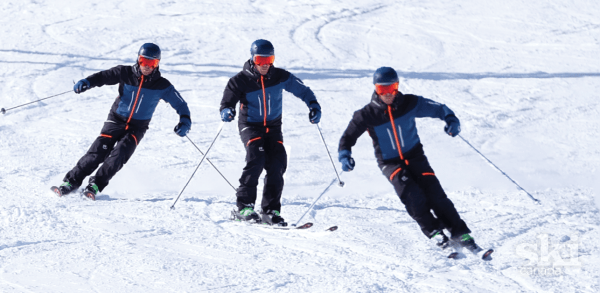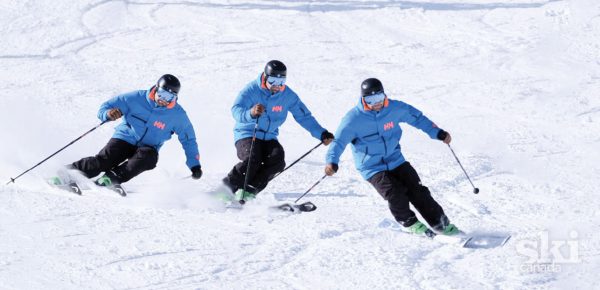We ask skiers at our ski camps about their goals for the week. Many tell us they want to “ski like an expert,” but they don’t have a specific goal in mind. We like to come up with something definable. After all, expert skiers make changes to their moves and tactics as they move around the hill, so our goals need to be changeable, too.
Let’s imagine we’re skiing on a groomer of moderate angle. In this case an expert’s goal might be to link carved turns at high speed, with grip maintained right through a rounded arc. We know the terrain, speed, turn shape and level of performance. It’s not as concrete as that golf thing of getting a little ball in a little hole, but it’s pretty good.
Achieving grip through the bottom of the turn is relatively easy, and a skier of advanced level can probably do this on good snow on mellow terrain. An expert skier, though, grips throughout the arc, even at the top. What does he do differently?
Look at the left-hand image in each sequence. Both skiers balance well through the bottom of the turn (let’s not nitpick!). Now look at the last image in each sequence, specifically at the angle of skis to the snow. You’ll notice the coach’s skis are tipped up much more than the advanced skier’s. A tipped-up ski grips better than a flatter one, allowing you to carve right through the arc.

The key lies in the middle images, where the difference in technique is most visible. You’ll notice that the masses of both skiers are more or less over their feet. The big difference is that the coach’s skis are still tipped up, and therefore still turning, even as his mass is pulled by momentum toward the camera. The coach lets his body pass over the skis, which roll inevitably onto the new edges. He knows the shape of the skis will come into play, causing the skis to return under him to catch and support his mass.

The advanced skier may understand this process, but he doesn’t quite believe it. He prevents his mass from moving over his skis, keeping the skis relatively flat so that he has the option of twisting (i.e. skidding) them to bring them around quickly to catch him. But in order to achieve this topple of the mass into the new turn, we need our skis to keep gripping through the transition. Our coach does this by steering the skis on a divergent path from that taken by his body, using the range of motion available to him in his lower joints.
It’s obvious in the photos that the coach’s legs are bent, while the advanced skier’s joints are pretty straight. This bending allows the coach’s legs to keep turning in his hips, and lets the body travel horizontally across the skis along the line of momentum, causing the early rolling and edging of the skis. The effect is much like that experienced when riding a bike through a series of linked turns: the bike moves one way while the body topples the other.
So next time you’re on a blue groomer, see if you can keep your ankles, knees and hips bent through the transition. You’ll notice the shins touch the front of the boots, and you’re able to let the feet keep turning longer across the hill. With practice you’ll be able to let your body topple across your skis and hang briefly downhill from your feet. You’ll feel the sidecut of the skis come into action and, just like that, you’ll be the best skier on the hill…on blue groomers at least.
TOBIN LEOPKEY is Program Director at Section 8 Snowsport Institute. Tobin, and partner NIGEL HARRISON, offer ski improvement camps for intermediate and expert skiers in all terrain and conditions in B.C., the Alps, Japan and Chile.
www.section8ski.com



